Best low light camera: Galaxy S8 vs Google Pixel vs LG G6 vs iPhone 7
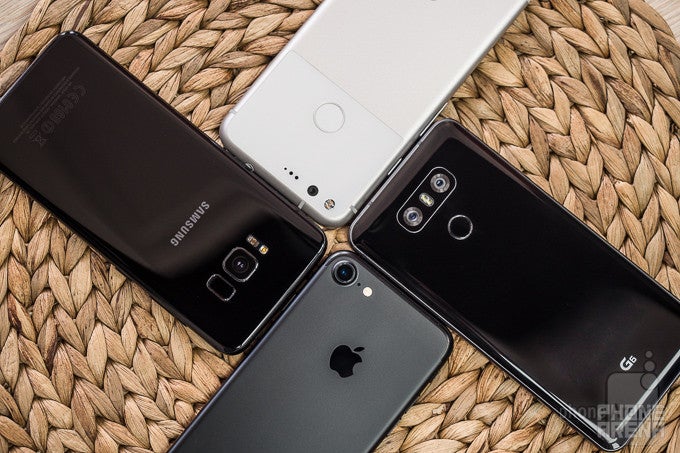
| Camera Specs | ||||
| Galaxy S8 | Google Pixel | LG G6 | iPhone 7 | |
| Resolution, aspect ratio | 12MP@4:3 4032x3024px | 12MP@4:3 4048x3036px | 13MP@4:3 4160x3120px | 12MP@4:3 4032x3024px |
| Sensor and pixel size | 1/2.55" 1.4μm | 1/2.3" 1.55μm | 1/3.06" 1.12μm | 1/3" 1.22μm |
| Aperture | F1.7 | F2.0 | F1.8 | F1.8 |
| Focus and stabilization | Dual-pixel AF OIS | PDAF/Laser DIS | PDAF OIS | PDAF OIS |
Camera specs sheet for quick reference
Scene 1
Click image to expand gallery and view the photos in a larger size. Use the "✚" button to zoom in. EXIF information is provided for each image
It's not quite dark out yet, but we're entering the so-called “blue hour”, which is the perfect starting point for our comparison. This way, we'll be able to see how the performance of the four cameras changes dramatically over the course of the next hours—from late at dusk, til after dark.
All four phones do a good job at capturing this scene, with some minor caveats, but let's see how each one handles the waning sunlight.
- The Galaxy S8 produces a good-looking image with warmer tones (as is usual for Samsung cameras), that represents the overall look of the scene better than the rest, in my opinion. In this scenario, the S8 chooses to shoot at 1/60 sec. and at a low ISO, which leaves us with a sharp, noise-free image, with well-preserved highlights.
- The Pixel, on the other hand, which is the only phone in this comparison not benefiting from OIS, opts for a higher shutter speed in order to compensate for the lack of image stabilization. This, in turn, forces the camera to choose a higher ISO value to expose the scene correctly, which then introduces more noise in the frame (most visible in the clouds). Still, the relatively low ISO value of 236, combined with the noise filtering that the Pixel applies to each shot, results in an overall good-looking image. I'm not overly pleased with how the highlights in the sky are blown, but that's likely because the Pixel didn't employ HDR+ for this scene. Neither did the S8, for that matter, but considering the technical differences, the Pixel may have benefited from some software trickery.
- The LG G6 manages to produce a very sharp, essentially noise-free image with well-balanced shadows and highlights. The G6 is neck to neck with the S8, although the LG camera has a slight edge in terms of resolution (13MP vs 12MP) and manages to deliver an all around sharper foreground.
- The iPhone 7 shot at a very low ISO, but this does not necessarily help it produce the best image. The photo from the iPhone is contrasty and with a lot going on in the clouds, which helps add some much-welcome dynamism to the scene. However, when examined in full-size, the image from the iPhone fails to impress. It's soft-ish and surprisingly noisy, especially given the low ISO value.
Scene 2
Click image to expand gallery and view the photos in a larger size. Use the "✚" button to zoom in. EXIF information is provided for each image
This time around, three out of four phones did a great job, while one of them lagged behind.
- The Galaxy S8 produces a vibrant and well-balanced image with little to no noise in the sky.
- The Pixel does its HDR+ magic to even things out and keep noise to the minimum and also leaves us with a good-looking image.
- The LG G6, however, does not fare so well in this scenario. Although taking advantage of LG's own HDR processing engine, the G6 fails at bringing out detail in the shadows and leaves us with a soft, murky-looking image that shows excessive amounts of sharpening.
100% zoom
- The iPhone 7 does an admirable job at preserving detail in the shadows and fares decisively better than the G6 in this trial. However, when examining the photo in full-size, the clouds and water don't look as smooth as they do on the photos from the Pixel and the Galaxy S8.
Scene 2.1
Click image to expand gallery and view the photos in a larger size. Use the "✚" button to enlarge. EXIF information is provided for each image
This scene is very similar to the one before it, in terms of light intensity, at least, but introduces a more prominent foreground. All phones fare similarly and expectedly to how they did in the previous scene, although here we can see that the G6 delivers a somewhat worse dynamic range than the rest. The G6 shot has the darkest shadows with the least detail.
Scene 3
Click image to expand gallery and view the photos in a larger size. Use the "✚" button to zoom in. EXIF information is provided for each image
- The S8 is spot-on here. The photo is sharp (in fact, it's the sharpest of the bunch), with rich detail on the stone fence and the ship. The rigging remains well-defined against a noise-free sky, although the sharpening mask has left some jaggies on some of the ropes. Still, the S8 has the best take on this scene.
- The Pixel doesn't do that great of a job here, unfortunately. The image is soft and noisy. Due to the lack of OIS, Pixel's camera is forced to choose a high ISO so as to expose the scene correctly and maintain a shutter speed that's manageable for handheld shooting.
- The LG G6 does an overall better job than the Pixel, but it's a step behind the Galaxy S8. The image is sharper than the one from the Pixel, but the noise filtering that was required to deal with the higher ISO has left its mark – parts of the rigging are not that well-defined and are almost blending with the sky behind.
- The iPhone 7 produces an image that's a tad softer than the one from the G6, but it's also less noisy. When compared to the Pixel, in this scenario, the iPhone 7 manages to deliver a sharper image with better defined highlights in the sky.
Scene 4
Click image to expand gallery and view the photos in a larger size. Use the "✚" button to zoom in. EXIF information is provided for each image
This scene is a tough one. We have a stark contrast between the darkness in the crowns of the trees above and the bright counterpoint that's the cathedral in the distance. Let's see how the four contenders cope with the dynamics of this scene.
- The Galaxy S8 again manages to strike a good balance between the dark foreground and the dazzling background. Although the street lights are a bit blown out, the cathedral is well-exposed, as is the alley where we're standing. The S8 also does an admirable job at pulling detail from the trees, especially given the very poor lighting. Further, the final result is sharp, despite the slow shutter speed (1/10 sec.), and noise-free, due to the low ISO chosen by the phone. Excellent job.
- The Pixel doesn't do a brilliant job here. The phone chose not to use HDR+ for this scene and delivered a soft, noisy, and somewhat underexposed image as a result. Without employing HDR+, the Pixel still managed to extract some detail from the crowns of the trees, which is commendable, but the noise is simply too much to appreciate this small feat. Either way, I decided to enable HDR+ just to see what happens. And here's what happened:
Interestingly, with HDR+ enabled, the Pixel brings out less detail from the shadows, leaving the crowns of trees almost pitch-black. On the other hand, it focuses more on reducing noise and applies a stronger sharpening mask over the image, which is especially noticeable around the well-lit parts of the photo. The cathedral definitely benefits from the boosted sharpness, but I'm not so sure about the darker areas of the image.
- The LG G6 pulls an unexpected J.J. Abrams with some crazy lens flares. The one in the middle is just too much. I didn't anticipate it at all, because the street light it's coming from is not even in frame, but it's so over the top that it detracts from the overall look of the photo, in my opinion. Although the image may appear at first glance dazzling, like a Pink Floyd light show with these crazy flares, the end result is disappointingly soft and unbalanced, with highlights that are too bright and shadows that are too dark.
- The iPhone 7 did very well here. The photo came out brighter than the one from the S8, and not as sharp, but the iPhone still managed to strike a good balance between shadows and highlights, leaving us with a noise-free, all around good-looking image.
Since the LG G6 surprised me in the last scene—very unpleasantly, at that—and looking at the photos I took with it, I was quickly reminded of all the fuss that surrounded the Pixel's camera last year. Shortly after Google's Android flagship launched in October of last year, people started complaining about the way its camera handled lens flares, and, well, let's just say that it was nothing compared to the G6.
The mighty lens flare
Flares appear when light direct light (for example, from the sun or a street light), hits the front of your lens. This can happen with any lens, but wide-angle lenses are in general more prone to flares, because they have a greater angle of view, and are more likely to catch a light light coming from the sides. And, since most phones are equipped with wide-angle cameras, flaring is one of the problems that you'll face when taking photos.
As you can see from the images above, lens flares are very pronounced in photos from the G6. Although cool-looking at times, they can be a great annoyance (as was the case in Scene 4). Flaring is a lot subtler on the S8 and the iPhone, although each one has its own unique look to it, and is more prominent on lights toward the edges of the frame. Lens flares on the Pixel are not that annoying, in my opinion, although I prefer the way the S8 and the iPhone handle bright sources of direct light. As you can see, the two topmost lights in the Pixel photo cause flares with something of a moire pattern to them, which is also accompanied by a subtler, circular flare toward the bottom of the frame.
Conclusion
Although all four cameras have their weaknesses and strong sides, and some did better than others in certain situations, one of them managed to deliver consistently better results across the board. And this is the Samsung Galaxy S8.
Although not a huge leap forward from last year's S7, technically speaking, the Galaxy S8 benefits from an improved camera software and image processing algorithms. These software advancements, coupled with the OIS system on board, help the S8 deliver an overall better-looking low-light shots than its otherwise worthy opponents. The other three are not far behind, but as is—between these four contenders, and as far as low-light camera performance goes—the Galaxy S8 has a clear edge.
Follow us on Google News


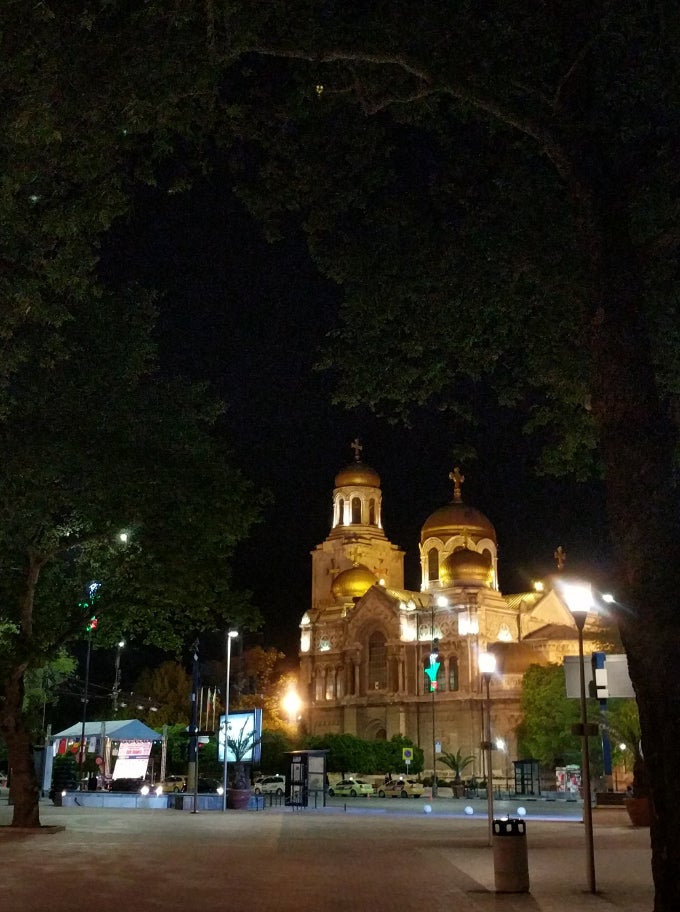


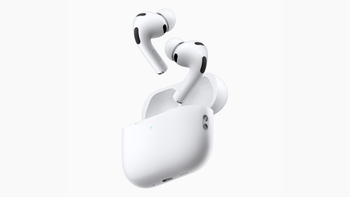
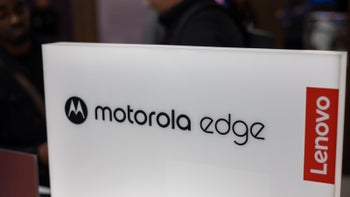
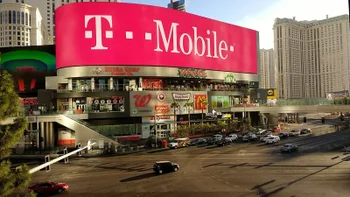
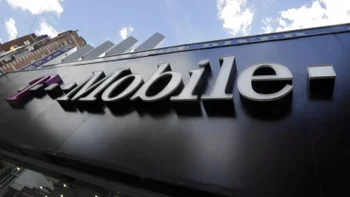

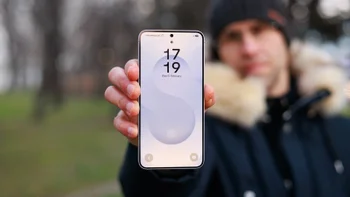
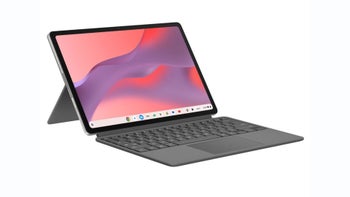
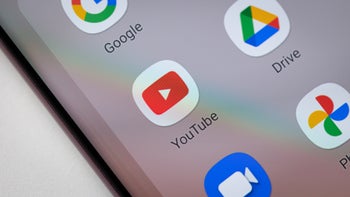
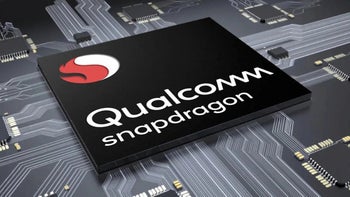
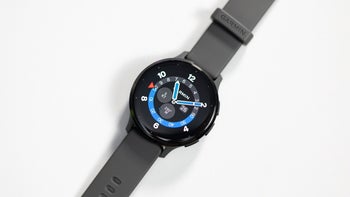
Things that are NOT allowed:
To help keep our community safe and free from spam, we apply temporary limits to newly created accounts: